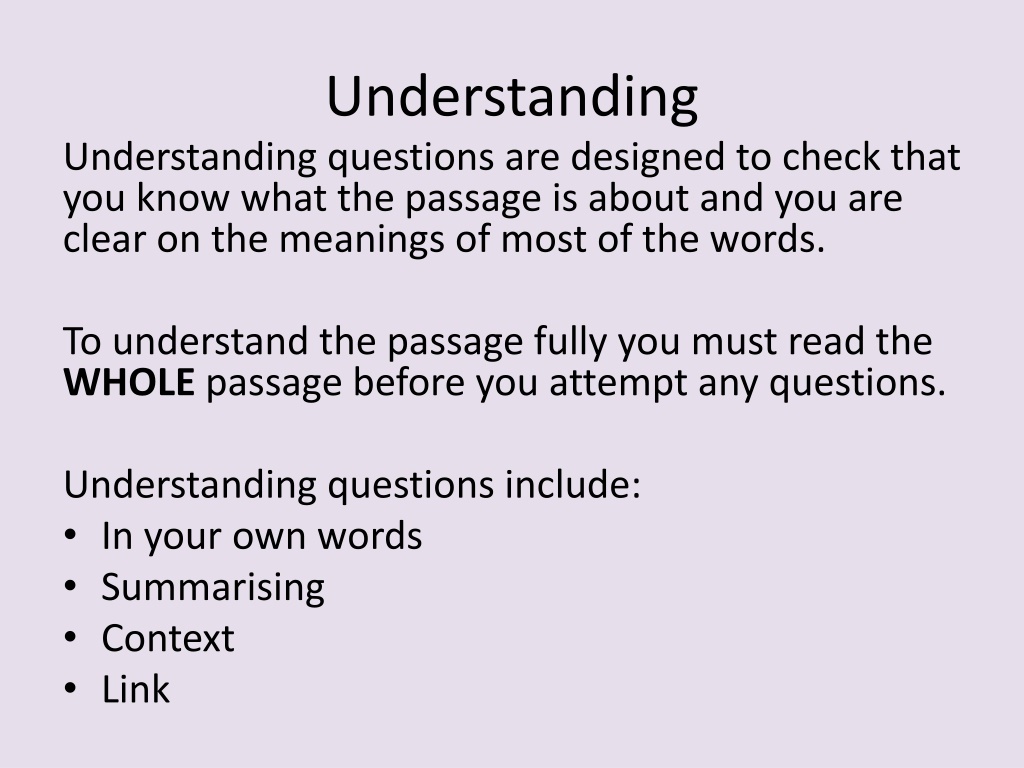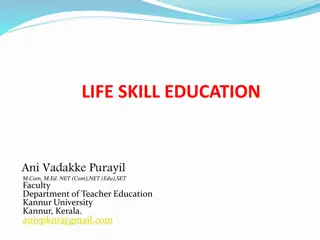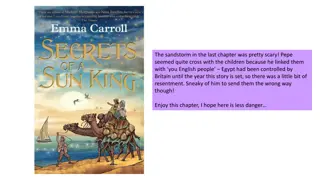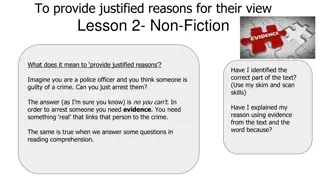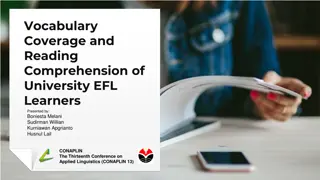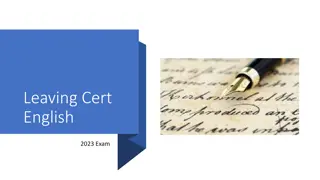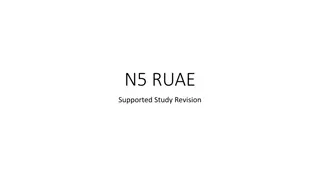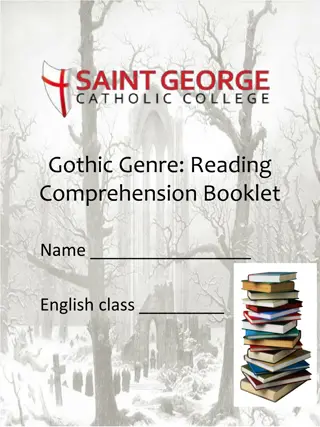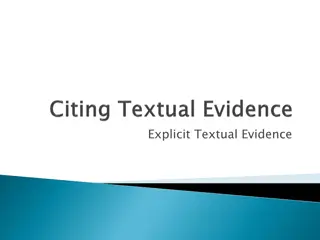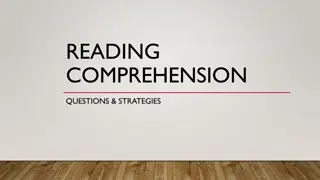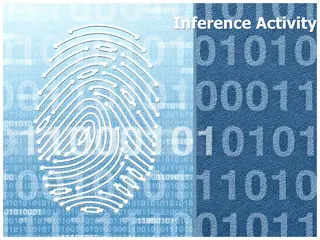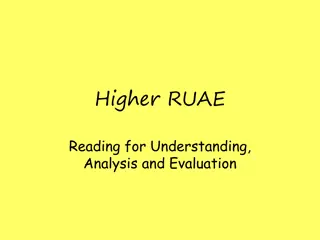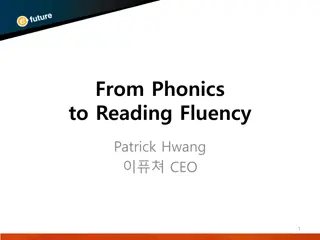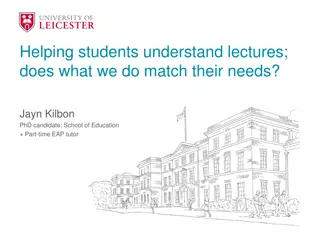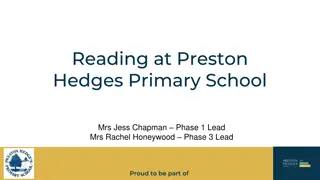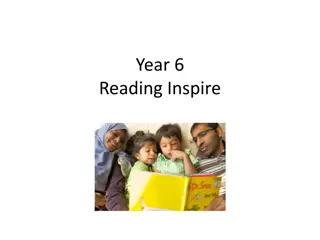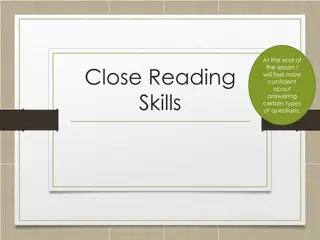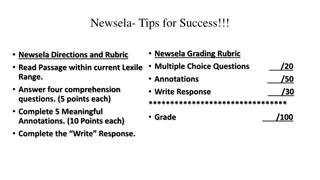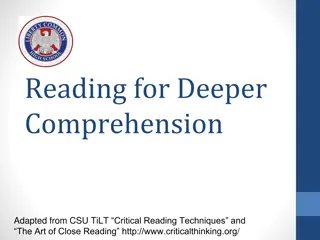Understanding and Mastering Comprehension Skills
Learn how to improve your understanding of passages through in-your-own-words exercises, summarizing key points, and tackling context questions. Enhance your vocabulary, comprehension, and reading skills by practicing these techniques before exams.
Download Presentation

Please find below an Image/Link to download the presentation.
The content on the website is provided AS IS for your information and personal use only. It may not be sold, licensed, or shared on other websites without obtaining consent from the author. Download presentation by click this link. If you encounter any issues during the download, it is possible that the publisher has removed the file from their server.
E N D
Presentation Transcript
Understanding Understanding questions are designed to check that you know what the passage is about and you are clear on the meanings of most of the words. To understand the passage fully you must read the WHOLE passage before you attempt any questions. Understanding questions include: In your own words Summarising Context Link
In your own words These should be simple the answer is already in the passage! The question asks you to put a part of the passage into your own words as this makes it clear you have understood the meaning. You must not quote from the passage unless the question specifically tells you to do so. Even if the question does not state in your own words you should attempt to do this wherever possible.
In your own words Method 1. Identify the answer from the text. Ask yourself: if I were to quote what would I write? . Highlight this if it helps. 2. Identify the key words. What could these be changed to in order for them to be put into your own words think of definitions, synonyms and antonyms. 3. Answer in bullet points one point per mark.
Summarising Again, these should be simple the answer is already in the passage! The question is asking you to pick out the key ideas only in order to summarise a section of the text. Don t go into too much detail only pick out what is important. Write summaries in your own words.
Summarising Method 1. Identify the key points from the text it sometimes helps to read the text, turn it over then write down what you think the most important points are. 2. Answer in bullet points one point per mark. Remember: do not include small details: names, dates etc. You must generalise.
Context questions These questions will test your vocabulary (to improve this you must read!) It will ask you to give the meaning of a specific word, identified in the question, then to give an explanation of how you worked out the meaning. From now until the exam look up any words you come across that you don t know the meaning of.
Context questions Method 1. Locate the word in the text and read around it (sentence before; sentence it s in; sentence after). 2. Work out and give meaning of word 3. In bullet points, quote and explain how the context helped you figure out the meaning (you must do this even if you knew the meaning already!)
Link Link questions are about how different sections/paragraphs in a passage link together. These questions are to do with the writer s ideas and how language links them together. One part of the identified sentence will link to the ideas before and one part will link to the ideas after.
Link Linking sentence Paragraph before Words or phrases which link back Words or phrases which link forward Paragraph after
Link Method 1. Quote the word/phrase that links back 2. Explain why it links (content) 3. Quote the word/phrase that links forward 4. Explain why it links (content) Formula The word/phrase .. links back to ., which was discussed in the previous paragraph when it says... The word/phrase .. introduces the idea of , which is explored in the next paragraph when it says ...
Example My mother was born near Gloucester, in the early 1880s. Through her father, John Light, she had some mysterious connection with the Castle, half-forgotten, but implying a blood-link somewhere. Indeed it was said that an ancestor led the murder of Edward II. But whatever the illicit grandeurs of her forebears, Mother was born to quite ordinary poverty. When she was about thirteen years old her mother was taken ill, so she had to leave school for good. She had her five young brothers and her father to look after, and there was no one else to help. Q. Show how the first sentence in the second paragraph acts as a link in the argument. 2 marks
Example My mother was born near Gloucester, in the early 1880s. Through her father, John Light, she had some mysterious connection with the Castle, half-forgotten, but implying a blood-link somewhere. Indeed it was said that an ancestor led the murder of Edward II. But whatever the illicit grandeurs of her forebears, Mother was born to quite ordinary poverty. When she was about thirteen years old her mother was taken ill, so she had to leave school for good. She had her five young brothers and her father to look after, and there was no one else to help. The phrase illicit grandeurs of her forebears refers back to the idea of the mother s connections with the Castle , and noblemen who murdered Edward II (1) The phrase quite ordinary poverty links to the idea of the difficult circumstances which follow in detail, such as the girl having to leave school to look after a large family of brothers because her mother was ill (1)
The phrase illicit grandeurs of her forebears refers back to the idea of the mother s connections with the Castle , and noblemen who murdered Edward II (1) The phrase quite ordinary poverty links to the idea of the difficult circumstances which follow in detail, such as the girl having to leave school to look after a large family of brothers because her mother was ill (1)
Question 2 The phrase eco-lobby s anti-flying agenda refers back to the restrictive air travel proposals discussed in the opening two paragraphs. The phrase their strategy as a whole / can we just review leads into the discussion of the eco-lobby s proposed restrictions on travel as a whole/on energy use in general.
Question 3 The phrase digs into the past refers back to the previous paragraph where the writer has selected, relived some of his greatest Olympic memories. The phrase without questioning / what was true and what was false leads into the discussion of Ben Johnson whose extraordinary performance turned out to be based on a lie, which casts a shadow over, calls into question all great Olympic performances.
Question 4 The phrase this condemnation or empty vessel or morally corroded or dark forces of anonymous markets refer back to the previous paragraph where the writer has discussed/outlined the critics negative view of shopping/shoppers. The phrase partial truth , too quickly , savouring that moment , enhance their lives , another diverting item links forward to the much more positive, enthusiastic view of shopping which is to follow in the next paragraph.
Question 5 The phrase the years as the golden boy refers back to the description of Alastair s successful school career (1) The phrase made a sad contrast leads up to the list of disasters which overtook him later at university (1)
Question 6 The phrase that kind of thinking links back to the view that video games are detrimental to children and that almost anything else would be better that was discussed in the previous paragraph. (1) The phrase all wrong introduces the counter- argument that criticism of video games is old- fashioned (which the writer finds hard to believe) which is discussed in the next paragraph. (1)
Link Method 1. Quote the word/phrase that links back 2. Explain why it links (content) 3. Quote the word/phrase that links forward 4. Explain why it links (content) Formula The word/phrase .. links back to ., which was discussed in the previous paragraph when it says... The word/phrase .. introduces the idea of , which is explored in the next paragraph when it says ...
Analysis Analysis questions are designed so you can examine HOW the author has achieved a particular effect. You can be asked about any aspect of language and you will have to analyse how it has created an effect. Analysis questions include: Word choice Imagery Tone Sentence structure Language
Word Choice In any piece of writing certain words are chosen by the writer to create a particular effect. To answer effectively you must know the difference between a denotation and a connotation. Denotation = dictionary definition Connotation = what the word implies or suggests. Word choice questions are asking you for the connotations of a word.
Word Choice Word Denotation Connotation Underweight Thin A clinical or medical term, being seen as in need of treatment Skinny Thin In an unattractive way, suggesting something angular and/or bony. Slim Thin In an attractive way, suggesting a smooth, elegant appearance.
Word Choice Method 1. Identify the word(s) in the passage. 2. Quote the word. 3. Give the connotations of the word. .. suggests . Remember: deal with each word separately!
Example We had a power cut on Tuesday evening. I sat in the dark, oddly relaxed. No e-mail. No telly. Not enough torchlight to read by. Meanwhile, my younger son thrashed from room to room, between Wii console, computer and TV, fretting that the shows he had Sky-plussed wouldn t record, scrabbling to see how much charge was left in his brother s laptop so that he might, at very least, watch a movie. When I laughed at his techno-junkie despair he exclaimed in white-hot fury: It s all right for you. To me it s it s like living in poverty. Show how the writer s word choice in the second paragraph conveys how much the loss of electricity affected the writer s son. 2 marks
Example We had a power cut on Tuesday evening. I sat in the dark, oddly relaxed. No e-mail. No telly. Not enough torchlight to read by. Meanwhile, my younger son thrashed from room to room, between Wii console, computer and TV, fretting that the shows he had Sky-plussed wouldn t record, scrabbling to see how much charge was left in his brother s laptop so that he might, at very least, watch a movie. When I laughed at his techno-junkie despair he exclaimed in white-hot fury: It s all right for you. To me it s it s like living in poverty. thrashed suggests uncontrolled, frenzied, slightly aggressive movement (1) fretting suggests anxious, nervous state of mind (1) scrabbling suggests desperate, frantic, near-hysterical (1) at very least suggests he is prepared to accept/welcome whatever he can (1)
Example thrashed suggests uncontrolled, frenzied, slightly aggressive movement (1) fretting suggests anxious, nervous state of mind (1) scrabbling suggests desperate, frantic, near- hysterical (1) at very least suggests he is prepared to accept/welcome whatever he can (1)
Question 2 "nonsense" suggests it is completely false, meaningless (1); "spouted" suggests that the stories are pouring out in an uncontrolled way, that the media are like some bore who rambles on and on (1); "(too) ubiquitous" suggests they can t be avoided, they overrun the media (1); "stupid" unequivocal description of the stories as brainless, almost insultingly so (1); "lazy" the reporters make minimal effort, not really concerned about the substance of the story (1); "churning out" suggests relentless production of something all the same, in large quantities (1); "cliches" suggests stories are predictable/old/tired/generalised (1) "easy (outrage)" the reporters are looking to stir up controversy without making much effort, they are lazy, undemanding (1)
Question 3 "enriches" suggests that reading adds to one's knowledge, awareness; is rewarding, beneficial; improves one (1); "the mind" suggests reading is influencing something greater than just the brain; it influences our consciousness: thought, perception, emotion and imagination (1); "deadens" suggests video games make kids less aware, less sensitive, less vigorous; they make kids think less; lifeless (1); "zoning out" suggests video games make kids detached from people and things around them, unresponsive, unstimulated (1)
Question 4 all seeing teachers eyes suggests avoidance of authority of the classroom eye traded suggests an illicit, appealing bargaining (marks of) rebellion exaggerates the significance of the swapping, but leaves the idea of the anti-authoritarian behaviour (statements of) suggests the dawning awakening of action not independence sanctioned by authority suspected / rather suggests a confused delight in thwarting the wishes they didn t of adults ever so much more suggests the excessive importance placed on a few relatively unimportant sweets enticing suggests the illicit, forbidden fruit idea not just food but suggests that the sweets had become an anti- authoritarian symbol food plus attitude suggests the sweets acquired a significance in the adoption of a stance against authority which soared beyond their importance as sweets
Question 5 "enriched" sense of improving, adding quality, "vibrant" suggests they are lively, dynamic, spirited, ... "significant" they are important, impressive, constructive, ... "friends/relatives/colleagues" unpromising choices, but might be used successfully
Question 6 sweep away suggests previous argument is rubbish and can be dealt with/dismissed very quickly apoplectic suggests uncontrolled, irrational anger froth suggests something insubstantial, trivial self-interested suggests middle classes only concerned with themselves, not the countryside posturing suggests middle classes concern is exaggerated, contrived, fake, affected look at the reality suggests truth is clear and incontrovertible recedes dramatically suggests rapid movement, significant diminution of threat overwhelmingly green emphasises full extent of Britain s rural make-up classified official nature of term reinforces accuracy, validity of statistic use of personal pronouns ( you we us our ) clear attempt to make the reader share his point of view/involve the reader personally
Question 7 freedoms suggests that travel offers people independence, broadens their horizons, ; experience suggests something life-enhancing; liberating (possibilities) suggests that travel allows people a freer, less constrained life-style; enlightenment suggests travel can result in a fundamental increase/transformation in people s knowledge or happiness; pleasure suggests enjoyment, gratification, ; (I reach for my) megaphone suggests strident, highly vocal, intense, I m-standing-on-a-soapbox-and-you d better- listen opposition; thousands (of people) suggests sheer number who have benefited from travel; (would never have) ventured suggests limited nature of parents experience as compared with current possibilities; (social) revelation suggests life-changing benefit
Imagery Imagery tells us what something is like by comparing it to something we might be more familiar with. You could be asked about a simile, metaphor, personification, alliteration (sound imagery) You must think about how the two things compared are similar and show you understand how the writer uses this to create an effect.
Imagery Method 1. Identify the image and quote 2. Identify the root of the image 3. Explain the denotation of the root of the image 4. Connect back to what it is being compared to using the connotations. . Just as ..root .. is denotation . so connect back using connotations
Example Twitter is the latest social networking craze to have conquered the ageing mainstream media, and using it is like sending out a universal text message to the whole planet. For many, this orgy of technology- enhanced wittering is simply something that we indulge in during our spare time, but it s not without its uses. Its coming of age is generally dated to the Mumbai terror attacks at the end of November, when minute-by-minute updates of the unfolding chaos zipped around the world from eye-witnesses armed with Twitter on their laptops and mobile phones. It was given another fillip on the geopolitical stage in January, when the Israeli Government used Twitter to snipe at the mainstream media and get across its reasons for invading Gaza. Show how the writer uses imagery in this paragraph to support the points he is making about Twitter in general and the media in general. 2 marks
Example Twitter is the latest social networking craze to have conquered the ageing mainstream media, and using it is like sending out a universal text message to the whole planet. For many, this orgy of technology-enhanced wittering is simply something that we indulge in during our spare time, but it s not without its uses. Its coming of age is generally dated to the Mumbai terror attacks at the end of November, when minute-by-minute updates of the unfolding chaos zipped around the world from eye-witnesses armed with Twitter on their laptops and mobile phones. It was given another fillip on the geopolitical stage in January, when the Israeli Government used Twitter to snipe at the mainstream media and get across its reasons for invading Gaza.
Example conquered just as to conquer means to fight and then overcome (1), so the mainstream media have been unable to fight off or resist Twitter, which is now a part of it (1) mainstream just as the mainstream is the principle current of a river (1), so the mainstream media refers to the traditional, safe, well-established media (1) orgy just as an orgy is a wild party involving indiscriminate (sexual) activity (1), so Twitter is seen by some as an uncontrolled/uncontrollable mess of communication lacking order and decency (1)
Example fillip just as a fillip is literally a snap of the fingers which suggests quick and lively action (1), so Twitter was given a snappy boost by the events in the middle east (1) (geopolitical) stage just as a stage is where the action of a play takes place (1), so world events can be seen as being performed, to be watched by the public (1) snipe just as to snipe is to shoot single targets from a hidden position (1), so the Israeli government, instead of launching a full scale attack on the press, made frequent small criticisms (1)
Tone Tone questions are asking you to analyse how something is said. This will reflect the attitude of the writer how he/she feels about what they are saying. In order to identify tone you should analyse the way language is being used: short or long sentences; punctuation; formal or informal; rhetorical questions etc. Examples of tone are: humorous, excited, flippant, formal, informal, chatty, critical, angry
Tone Where have you been?! Where ve you been? What s the difference?
Tone Method 1. Identify the tone (if it has not already been identified in the question) 2. Quote the words/phrases that create that tone (look at the language) 3. Explain how the chosen words/phrases create that tone (analysis)
Example Bond electrocutes people, harpoons them, strangles them, feeds them to piranha fish, dumps them into pits of boiling mud, explodes them with shark gun pellets, drops them off cliffs, throws them from airplanes, sets them on fire, and sometimes just shoots them. He doesn t agonise over it later. He doesn t wonder if he did the right thing. No, one of the things that characterises Bond is moral certainty. He knows who the bad guys are, and he knows they deserve it. Bond relies entirely on his own judgement, and is sure of his moral authority to punish evildoers. Show how the writer creates both a humorous and a serious tone. In your answer you should refer to such features as sentence structure, word choice . . . 4 marks
Humorous tone 1. the list of killings the excessive length of the list; the sheer variety of killing methodology; the breathlessly rapid fire nature of the exemplification; the pulsatingly indulgent beat of the verbs; the increasingly esoteric, arguably ridiculous, nature of the killings: all of these serve to create a comic effect in capturing the cartoon-like mayhem of Bond s world brings list to a delightful prosaic, downbeat conclusion, just when it seems an even more spectacular example is inevitable 2. use of anti-climax to end list ( and sometimes just shoots them. ) 3. word choice in list some candidates may comment on the rather informal nature of some of the verbs ( dumps , explodes ) and how this adds to the trivialisation of death creates a throwaway, conversational style, perhaps mimicking the quickness of Bond s decision-making. The continuation of the staccato style of the opening sentence and the parallel structure of these two sentences arguably add to the punchy, comic impact of these sentences 4. repetitive use of short, punchy sentences ( He doesn t agonise , He doesn t wonder ) 5. further use of punchy language ( He knows and he knows ) continues the throwaway, conversational style described in point 4 6. the bad guys this simplistic reference to Bond s enemies reinforces the cartoon-like portrayal of the battle between good and evil presented in the opening sentence word choice here has echoes of the deadpan, nonchalant humour of pulp fiction 7. they deserve it
Serious tone 8. use of short, punchy sentences ( He doesn t agonise , He doesn t wonder ) candidates may see these sentences as being much more serious than the reading described in point 4. They may focus on the repetition and the parallel structure as emphasising Bond s unwavering, unequivocal moral certainty 9. emphatic No at the start of the antepenultimate sentence stresses the strength of the writer s feelings on something as serious as Bond s moral certainty 10. repetition of he knows in penultimate sentence conveys the unwavering, absolute certainty of Bond s moral judgements 11. authoritative nature of final sentence after the various stylistic devices which permeate this (and the previous) paragraph, the final sentence is well-balanced, considered and somewhat magisterial 12. elevated language of the final sentence the language of the final sentence is formal and elevated ( judgement , moral authority , evildoers ), establishing a tone of absolute certainty 13. contrasting register in final two sentences the final two sentences have similar meanings but the elevated nature of the final sentence is emphasised by the differing register of the two sentences: evildoers instead of bad guys , judgement and moral authority instead of he knows they deserve it
Sentence Structure Structure = what glues the words together (punctuation) and the order they are put in (length/ repitition). Word Word Word
Sentence Structure Sentence structure questions are asking you about how the words are put together to create an effect. It is essential to understand punctuation, sentences types and word order. It is not about word content! But it is not enough just to identify the type of structure used you must relate it to the content.
Sentence Structure Method 1. Identify type of sentence structure 2. Quote sentence where structure appears (if it is not too long) 3. Explain the effect of the sentence structure (relate it back to content and what the writer is trying to say)
Example When the world was a simpler place, the rich were fat, the poor were thin, and right-thinking people worried about how to feed the hungry. Now, in much of the world, the rich are thin, the poor are fat, and right-thinking people are worrying about obesity. Identify two ways by which the sentence structure in these lines emphasises the change in concerns of right-thinking people . 2 marks
Example When the world was a simpler place, the rich were fat, the poor were thin, and right-thinking people worried about how to feed the hungry. Now, in much of the world, the rich are thin, the poor are fat, and right-thinking people are worrying about obesity. Question asks for identification only: Parallelism/balanced construction Series of contrasts ( when/now fat/thin feed the hungry/ obesity ) Repetition of rich poor right-thinking
Language Language questions combine all of the types of analysis questions we have looked at so far. They are often worth more marks (4-6) per question and will normally give you a list of techniques to consider You may consider word choice, imagery, tone, sentence structure . It may also limit these choices. You should identify each technique separately and analyse it separately using the methods we have talked about.
